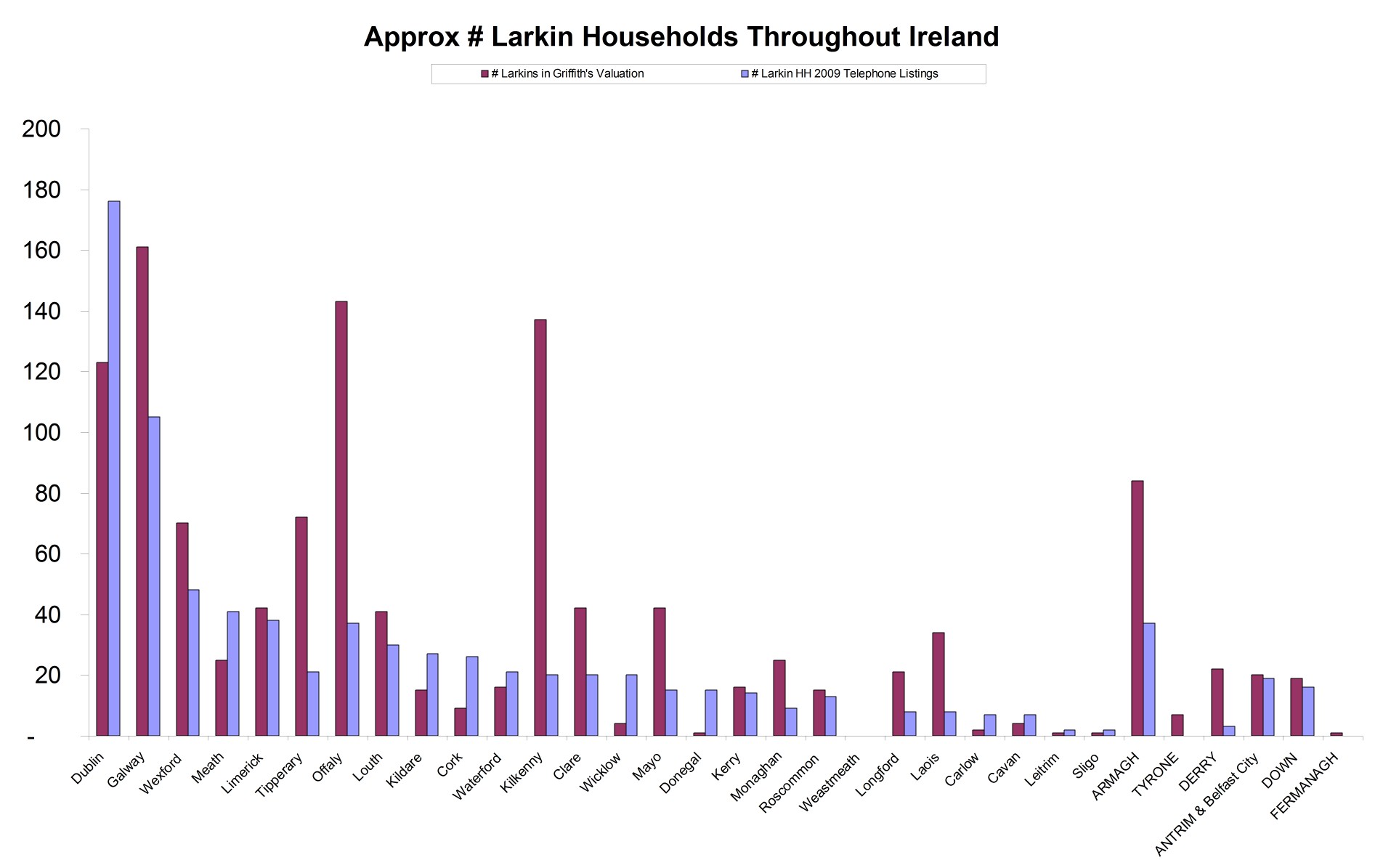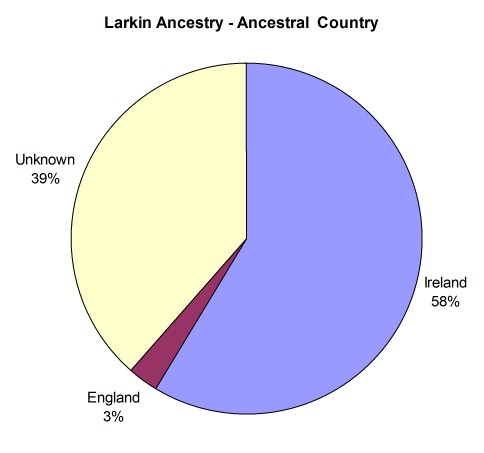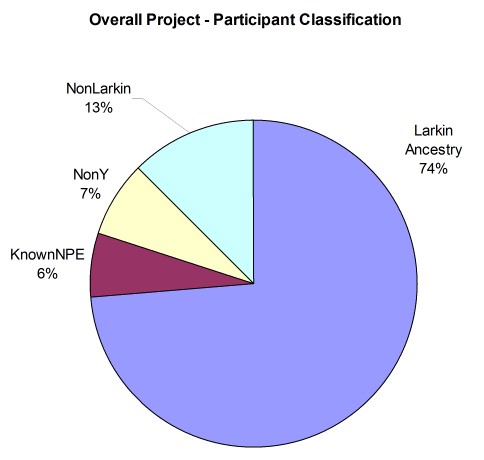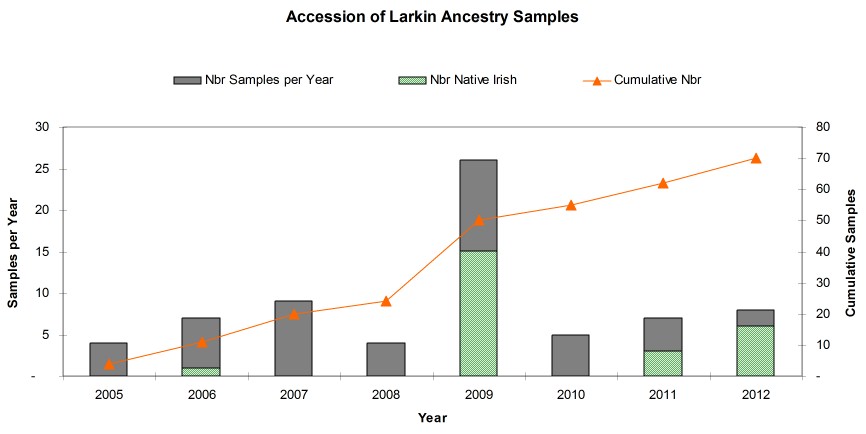Abstract
The Larkin DNA project continues a sampling effort to link Y-STR haplotypes with specific ancestral geography to serve as a guide for genealogical research. The Type 12 group previously identified has been expanded and confirmed in County Wexford. Two new Types have been identified in Ulster which are part of the L21 clade of the R1b haplogroup. Type 15 has the distinctive DYS425 deletion associated with Clan Colla. Type 16 is diverse but lies within the L21 clade and probably represents the Ulaid tribes native to Ulster prior to 400 CE. Samples characteristic of Larkin Type 01 previously identified in the Shannon River valley were also found in Ulster supporting a shared Ui Niall ancestry between Ulster and the Irish midlands.
Funding Statement
Copyright © 2012 Bradley T. Larkin. Substantial funding was provided by a participant who wished to remain anonymous.Introduction
The mission of the Larkin DNA Project is to use DNA testing in conjunction with traditional genealogy to identify the origins and movements of persons with the Larkin surname. In order to make connections to specific history and geography, we need to identify both Y-STR haplotypes and their geographical location in the era of written records. To get closer to the origin of the surname, a recruiting strategy called Ancestral Parish Sampling is used to recruit natives of Ireland from areas with continuity of the surname in historical records. The term “ancestral parish” refers to the geography of the 19th century Irish civil parish in which a participant’s earliest known patrilineal ancestor lived. By combining the participants’ ancestral knowledge with historical records, we infer the Ancestral Parishes of the DNA haplotypes collected. When persons with Larkin paternal ancestry around the world match these haplotypes, the geographic linkage from this sampling effort provides a focus for searching 19th and 20th century Irish records.
In 2009 the Larkin DNA project undertook an Ancestral Parish Sampling effort in conjunction with the Larkin Clan Gathering in County Galway, Ireland16. A report of those findings was published in 2010 which identified fourteen (14) 37-marker Y-STR haplotype groups. The majority of samples were classified as R1b-M222 and linked to a homeland called Muinter Lorcán in the Shannon River Valley with potential descent from 5th century CE Gaelic king Máine Mór and Ui Neill king Niall of the Nine Hostages.1 This paper reports progress of Ancestral Parish Sampling for 2011 and 2012 which focused on DNA collection from men in the traditional Irish provinces of Ulster and Leinster.2
Methods and Materials
Sampling
In total, the Larkin DNA project has ninety-five (95) participants of which seventy (70) have paternal Larkin Ancestry as characterized in Table 1, Figure 1, and Figure 2. The majority of participants are of Irish descent with Y-DNA results in haplogroup R1b.
Term
Definition
Larkin Ancestry
Male project participants who have taken a Y-STR DNA test and whose earliest known paternal ancestor used a form of the Larkin surname
Known NPE
Male project participants who have the Larkin surname but who are aware of one or more paternal ancestors who was not named Larkin (a.k.a. non paternal event)
NonY
Project participants who are believed to have Larkin ancestry but it is not on the Y chromosome (e.g. daughters, maternal descent, etc).
Non Larkin
Persons who have participated in the Larkin project but do not have known Larkin ancestry (e.g. spouses, in-laws, etc.)
Fig. 1: Ancestral Country of Larkin Ancestry Participants
Recruitment was conducted using Larkin telephone listings from Ulster14 and Leinster15 to identify men native to Ireland with Larkin paternal ancestry from rural areas with a long continuity of the surname in historical records. Recruitment of modern Larkins living in major cities in Ireland was avoided because the Gaelic Irish population was overwhelming rural prior to the 20th century.
Fig. 2: Characterization of All Project Participants
In total, nine (9) new samples from Irish natives were collected in 2011 and 2012 of which six (6) came from Ulster and three (3) from County Wexford. An additional six (6) test kits sent during this period have not been returned implying a 60% success rate on kits dispatched. Each respondent was queried for their ancestral knowledge by telephone and email with additional genealogical research conducted using the 1911 Census of Ireland and Griffith’s Valuation of Ireland. Appendix 2 contains a statistical summary of the Larkin records extracted for all thirty-two (32) Irish counties. Table 2 shows a summary of the project sampling effort to date in comparison to the households found in the telephone listings to give some idea of coverage.
Fig. 3: Plot of Larkin Ancestry Samples Collected by Year
(a)Donegal sample had ancestral attribution to County Mayo. (b) Note that Monaghan ancestral sample came from person living in Cavan today. (c) Two unreturned kits date from the 2009 sampling effort.
County
# Sample Kits Sent
# Unreturned
# Sample Kits Returned
# Larkin Telephone Listings
Household Coverage
Derry
1
-
1
3
33%
Tipperary
6
1
5
21
24%
Laois
1
-
1
8
13%
Monaghan
2
1
1 (b)
9
11%
Antrim & Belfast
2
-
2
19
11%
Galway
7
-
7
105
7%
Donegal
1
-
1 (a)
15
7%
Wexford
4
1
3
48
6%
Offaly
2
-
2
37
5%
Clare
1
-
1
20
5%
Armagh
3
2
1
37
3%
Kilkenny
3
3
-
20
0%
Cavan
-
-
- (b)
7
-
Limerick
-
-
-
38
-
All Other Areas
-
-
-
418
-
Totals
33
8 (c)
25
805
3%
Figure 4 shows a map of Irish parish-level ancestry for all Project participants identified to date. With a few exceptions, coverage of the geographical areas associated with the Larkin surname from Irish Annals and place names is becoming strong.
Fig. 4: Larkin Ancestral Parishes Identified in Ireland
DNA Test Methods
All recruited samples were given FTDNA3 37-marker Y-STR tests. Based on those results, clustering analysis, and comparison to other Larkin project results from outside Ireland, some samples were selected for additional STR and SNP measurements useful in comparing and contrasting R1b subclades.
Analysis
Sample Classification
Y-STR TMRCA Using RCC Method
Appendix 1 shows Y-STR results for all the twenty-five (25) native Irish samples collected to date. Larkin Y-DNA samples have been classified in sixteen (16) R1b haplotype project clusters (called Types) using SNP classification, time to most recent common ancestor (TMRCA) based on estimated mutation rates412 , phylogenetic trees1011 , and relative correlation coefficient (RCC) analysis5 . There were fifty (50) samples with Larkin Ancestry and 37-marker Y-STR results for men not known to be more closely related than 2nd cousins. Appendix 3 includes a summary of all sixteen Types. Fourteen of the Types were identified in the previous paper, but two new groups have been identified from Ulster: Type 15 and Type 16.
Fig. 5: Phylogenetic Network of R1b Larkin Types
Fluxus Network software 4.6.0 median joining network with e = 0.
Table 3 shows the time to most recent common ancestor (TMRCA) within and between clusters using average values of Howard’s RCC approach. These values suggest a Larkin progenitor for Type 15 in the era when surnames came into use in Ireland – about 950 CE. For Type 16, the TMRCA value is higher and speaks to the diversity of STR values within this group whose common ancestor probably lived in pre-historic times.
TMRCA in years based on RCC Analysis. Intracluser values estimate age of proginetor within each Group. Intercluster values estimate age to common ancestor of both groups.
Type 01
Type 02
Type 03
Type 06
Type 07
Type 08
Type 09
Type 11
Type 12
Type 15
Type 16
n
12
6
2
6
2
3
1
1
3
3
3
Type 01
561
1,874
1,798
3,045
4,322
3,537
1,710
4,122
2,529
2,267
2,764
Type 02
1,874
634
1,615
2,977
2,437
3,416
2,518
3,928
2,423
2,921
2,381
Type 03
1,798
1,615
307
3,155
3,102
3,691
2,605
4,475
3,202
3,686
3,122
Type 06
3,045
2,977
3,155
229
2,703
2,498
3,522
6,243
2,424
2,518
2,371
Type 07
4,322
2,437
3,102
2,703
406
2,711
3,456
4,242
3,071
3,056
2,308
Type 08
3,537
3,416
3,691
2,498
2,711
409
2,459
4,766
2,789
3,027
2,962
Type 09
1,710
2,518
2,605
3,522
3,456
2,459
-
1,544
2,370
2,539
2,480
Type 11
4,122
3,928
4,475
6,243
4,242
4,766
1,544
-
4,279
4,428
3,747
Type 12
2,529
2,423
3,202
2,424
3,071
2,789
2,370
4,279
314
2,624
2,084
Type 15
2,267
2,921
3,686
2,518
3,056
3,027
2,539
4,428
2,624
1,065
2,579
Type 16
2,764
2,381
3,122
2,371
2,308
2,962
2,480
3,747
2,084
2,579
1,842
SNP Analysis
Table 4 shows findings for R1b Larkin Ancestry participants tested for single-nucleotide polymorphisms (SNP). Using the TMRCA findings in combination with the genetic branches attributed to SNPs by ISOGG6 a notional phylogenetic tree of R1b Larkin Types was constructed (Figure 6)13 .
Legend: 1 = Tested Positive for SNP; 0 = Tested Negative for SNP; a = Presumed positive for SNP based on other SNPs and ISOGG 2012; b = Presumed positive for SNP based on other SNPs and ISOGG 2012
ID
Project Cluster
L21
DF23
M222
P66
Z253
L226
DF21
DF25
DF5
L554
L895
SNP Subclade within Haplo-group R1b
L-0039
Type 07
1
1
0
0
b
0
0
DF23
L-0006
Type 01
1
1
1
0
b
M222
L-0059
Type 12
1
0
1
0
0
0
0
Z253
L-0031
Type 09
a
a
1
L226
L-0047
Type 11
a
a
1
L226
L-0088
Type 15
a
b
b
1
0
DF21
L-0083
Type 15
a
b
b
1
0
0
DF21
L-0079
Type 16
1
0
0
L21*
Fig. 6: Radial Cladogram of Larkin R1b Types
Based on TMRCA from mutation rates with branches adjusted to ISOGG 2012 SNP tree.
Analysis of Ulster Samples
Irish annals mention the name Lorcán in the year 879 CE in the areas where the surname is found in Ulster today. While the pedigrees and attribution in the genealogies have been debated, one researcher noted:
“These families are all noted in the Annals and are from two races - the Clan Colla of Oriel and the Ui Eathach Cobha (Iveagh, Co. Down) an ancient Clanna Rory tribe of Ulidia (ancient Ulster).”7
Another theory is that some Larkins in this area descend from migrations of R1b-M222 Ui Neill’s who went on to settle in the Shannon river valley under Máine Mór in the 5th century CE (Types 01 and 02). If this theory is supported by Y-DNA, then we expect to also find representation from those Types in the Ulster samples.
The findings summarized in Table 5 support all of these hypotheses. Because the Clan Colla group with the DYS425 deletion has been well sampled, we can confidently attribute Larkin Type 15 as descending from one of the Three Collas of Airghiallagh8 . Subsequent SNP testing for DF21 on both of the samples was also positive as would be expected for Clan Colla. At least one American Larkin lineage has been able to connect its ancestry to Ulster because of this finding.
Larkin Type 16 from Ulster is a very diverse group with the L21 SNP but none of the currently identified SNP sub-branches. Type 16’s suggested age from Table 3 (1,842 years) is almost double that of Type 15 (1,065 years). This finding combined with the written accounts of a tribe significantly older than Clan Colla in Ulster suggests that Type 16 is likely descended from the Ulaid tribes native to Ulster prior to 400 CE and the Clan Colla and Ui Niall ascendancy.
Two samples from Ulster had STR patterns associated with Larkin Type 01 (R1b-M222 Ui Niall) from the Shannon River valley. In one case (L-0084) the participant had knowledge of a 19th century origin in County Mayo. In the other case, the participant attributed his roots solely to County Armagh. As the TMRCA estimates for both men are in the middle of the Type 01 cluster, it is indeterminate whether this family group remains in Ulster from an early Ui Niall branch or moved there during the Norman period, albeit such movement would have been against the tide of political events of the 16th to 18th centuries.
Project Cluster
# Native Irish Identified
Disinguishing Markers & Comments
Type 15
2
SNP L21+, DF21+, DF25-, DF5-
DYS 425 = NULL, DYS 439=14, CDYb = 38
Ancestral parish of Ballyscullion, County Derry (L-0088) with representation in Belfast (L-0083)
Type 16
2
SNP L21+, DF21-, DF23-DYS 456 = 15, DYS 460 = 10
Ancestral parishes of Magheross, County Monaghan (L0079) and Drummaul, Co Antrim (L-0087).
Type 01
2
SNP L21+, DF23+, M222+
DYS 464b = 15; DYS 576 = 17
Ancestral parishes of Forkhill, County Armagh (L-0085), Letterkenny, County Donegal from Bohola, County Mayo (L-0084).
Fig. 7: Map of Ulster Ancestral Parishes
Analysis of Wexford Samples
Genealogies and Annals suggest that the Larkin sept in Leinster originates from
“Lorcán, son of Felim, king of Leinster from 923 until his death in Dublin 941.”921
This Lorcán is thought to descend from Cathaoir Mór, High King of Ireland in 122 CE. With such political prominence, this sept was expected to be more homogenous than the other Larkin groups and, in Y-DNA terms, distinct from the other clusters. The findings summarized in Table 6 and plotted in Figure 8 show consistency and distinctness from other Larkin groups and suggest that all of these men descend from a common ancestor in the era of surnames. Like most Irish males, they are positive for SNP L21 but are also positive for SNP Z253 as listed in Table 4. Unfortunately, no samples from County Kilkenny have been returned so the hypothesis that this group has a shared ancestry with Type 12 could not be evaluated.
Project Cluster
# Native Irish Identified
Distinguishing Markers & Comments
Type 12
3
SNP L21+, L226-, Z253+
DYS 439 = 11, DYS 458 = 16
Owenduff, New Ross, Enniscorthy of County Wexford
Fig. 8: Map of Wexford Ancestral Parishes
Conclusions
The Larkin group (Type 12) in County Wexford, Ireland does seem distinct and consistent with one native haplotype found there. In Ulster, the Y-DNA findings support the earliest annalistic records of older tribes (Type 16) supplanted by Clan Colla (Type 15) and the Ui Niall. Thus, in the case of the Larkin surname in Ulster, the Y-DNA findings support the earliest annalistic records, even where those records appeared confused to later researchers – as there are indeed persons sharing the Larkin surname in Ulster with three different patriarchs.
Acknowledgements
Thanks to all those who contributed a sample and showed patience with transatlantic telephone calls on an unusual subject in an American accent. Thanks also to Josiah McGuire and all the leaders of the Clan Colla DNA project who explain the history, genealogy and DYS425 Null phenomenon very well on their outstanding web site. Thanks also to Patrick B. Larkin of County Galway and David A. Larkin of Australia for their long research and compilation of Larkin genealogy. Special thanks to Aidan Kelly (DF23+ M222-), Peter Biggins, Josiah McGuire, Patrick McMahon, Adrian Martyn, and David A. Larkin who provided comments on a draft version of this paper.Appendix 1
Y-STR Values for Native Irish Samples with Larkin Ancestry
See attached data file with anonymous data covering STR and SNP results and analyses.17
Appendix 2
Larkin Population in Ireland by County Across Three Datasets
See attachment Larkin Population In Ireland with statistics and charts of research on Larkin households and population by county for the three different historical datasets:
Coverage includes areas today known politically as the Republic of Ireland and Northern Ireland.
Vertical bar chart by county showing the number of Larkin households in each county for both Griffith's Valuation and the 2009 telephone listings.
Fig. 1: Approximate Number of Larkin Households in Ireland
Appendix 3
Summary of R1b Larkin Types
Numbers identified include worldwide participants with 37-marker tests, not just Irish natives.
Project Cluster
# Identified with 37 Markers
Distinguishing Markers & Comments
Type 01
15
SNP L21+, DF23+, SNP M222+DYS 390 = 25, 26;
DYS 19 = 14DYS 385b = 14; DYS 464b = 15; DYS 449 = 27; DYS 576 = 17
Most common haplotype in North Tipperary and East Galway area around the Shannon River. Ancestral parishes include: Lorrha, Dorrha, Knigh, & Aghnameadle in Co Tipperary; Clonfert, Tynagh, & Loughrea in County Galway. In Ulster, ancestral parishes of Forkhill, County Armagh, Letterkenny, County Donegal from Bohola, County Mayo.
Type 02
7
SNP L21+, DF23+, M222+
DYS 390 = 25, 26; DYS 19 = 14; DYS 460 = 12; DYS 458 = 18; DYS 449 = 29
Includes Kiltormer Larkins from around Aughrim area of Galway as well as the Lusmagh and Coolderry Larkins of County Offaly. Ancestral parishes include Ettagh & Lusmagh in County Offaly; Killimorbologue, Killallaghtan & Clonfert in County Galway.
Type 03
2
SNP L21+, DF23+, M222+
DYS 390 = 25, 26; DYS 19 = 14; DYS 458 = 18; DYS 449 = 30; DYS 576 = 17
Haplotype is very close to R1b-M222 modal. Family origin is American immigrant from County Galway but no ancestral parish identified.
Type 04
1
SNP L21+, DF23+, M222+
DYS 459b = 11; DYS 391 = 10; DYS 389-1 = 14; DYS 390 = 25, 26; DYS 19 = 14
County Galway origins but no ancestral parish identified.
Type 05
2
DYS 447 = 24; DYS 442 = 13
Members with known ancestry trace to British Isles. Includes descendant of Larkin Soap Company founder John Durant Larkin of Buffalo, NY. Ancestral parishes include Beckley, Sussex County, England.
Type 06
6
DYS 437 = 14; DYS 460 = 10
American colonial ancestry to 1655 Newport, Rhode Island but no old world parishes have been identified.
Type 07
2
SNP L21+, DF23+, M222-
DYS 449 = 31,32; DYS 413a = 21; DYS 557 = 17
Ancestral parishes are Kilseily in County Clare and Templetouhy in County Tipperary. Also matches the SNP and STR signature of the William Boy O’Kelly lineage of the last Gaelic chiefs of Ui-Maine (L21+, DF23+, M222-; DYS 413a = 21, DYS 557 = 17, DYS 565 = 11, DYS 456 = 15, DYS 481 = 24)18
Type 08
3
DYS 19 = 15; DYS 389-1 = 12
Ancestral parishes of Fahy and Kilmacduagh in County Galway.
Type 09
1
SNP L21+, Z253+, L226+
DYS 447 = 25; DYS 464b = 15; DYS CDY a-b = 37-39
Part of Irish Type III cluster. Ancestral parish is Killarney in County Kerry.
Type 10
1
DYS 392 = 13; DYS 459a = 9; DYS 439 = 13
Origin story is of American immigrant from Dublin. No ancestral parishes identified.
Type 11
1
SNP L21+, Z253+, L226+
DYS 447 = 23; DYS 464c = 13
Part of Irish Type III cluster. Ancestral parish is Borris (Portlaoise) in County Laois.
Type 12
3
SNP L21+, Z253+, L226-
DYS 439 = 11, DYS 458 =- 16
Owenduff, New Ross, and Enniscorthy in County Wexford.
Type 13
1
DYS 390 = 23; YCA IIb = 22; DYS 607 = 14
American immigrant from Ireland to Rochester, New York. No ancestral parish identified.
Type 14
1
DYS 390 = 21; YCA IIa = 22; DYS 449 = 30; DYS 437 = 16
R1b but not from AMH cluster.
Ancestral parish is Kilsheelan in County Tipperary (South).
Type 15
3
SNP L21+, DF21+, DF25-, DF5-
DYS 425 = NULL; DYS 439=14; CDYb = 38
Ancestral parish of Ballyscullion, County Derry with representation in Belfast.
Type 16
3
SNP L21+, DF23-, M222-
DYS 456 = 15, DYS 460 = 10
Ancestral parishes of Magheross, County Monaghan and Drummaul, Co Antrim.
References
- Larkin BT (2009) Larkin DNA Project - Ancestral Parish Sampling on the Shannon River. Journal of Genetic Genealogy, 6(1).
http://www.jogg.info/62/files/Larkin.pdf - Wiikipedia (30 October 2012) Geography of Ireland. Note that references in this paper to ‘Ulster’ refer to the traditional geography of nine counties. References to ‘Ireland’ refer to the entire island of 32 counties. If reference is made to the specific geographical area of the modern political entities, those will be referred to as either the ‘Republic of Ireland’ or ‘Northern Ireland’ (the six counties which are part of the United Kingdom). Most other geographical references such as ‘Leinster’ and ‘Wexford’ are well understood.
http//en.wikipedia.org/wiki/Geography_of_Ireland - FTDNA is an abbreviation for Gene By Gene, Ltd doing business as Family Tree DNA, a commercial provider of genealogical DNA testing in Houston, Texas.
http://www.familytreedna.com - McGee D (2008) Y-DNA Comparison Utility
http://www.mymcgee.com/tools/yutility.html - Howard WE III (2009) The Use of Correlation Techniques for the Analysis of Pairs of Y-STR Haplotypes, Part 1: Rationale, Methodology and Genealogy Time Scale. Journal of Genetic Genealogy, 5(2):256-270.
http://www.jogg.info/52/files/Howard1.pdf - International Society of Genetic Genealogy (2012). Y-DNA Haplogroup Tree 2012, Version: 7.62, Date: 8 October 2012.
http://www.isogg.org/tree - Larkin DA (2000) The Ancient Septs of ÓLorcain. Queensland, Australia. Adapted from an unpublished Dip FHS Thesis (1985) originally printed as The Five Septs of Lorcain (1987).
- Biggins P, McGuire J, McMahon P, Roderick T, DNA of the Three Collas.
http://www.peterspioneers.com/colla.htm - Larkin DA (2000) The Ancient Septs of ÓLorcain. Queensland, Australia, p. 17 with references to the Annals of the Four Masters for the year 941 CE.
- Bandelt H-J, Forster P, Röhl A (1999) Median-joining networks for inferring intraspecific phylogenies. Mol Biol Evol 16:37-48.
http://mbe.oxfordjournals.org/content/16/1/37 - Fluxus Network software.
http://www.fluxus-engineering.com - Walsh B (2001) Estimating the Time to the Most Recent Common Ancestor for the Y chromosome or Mitochondrial DNA for a Pair of Individuals. Genetics 158, p. 897-912.
http://www.genetics.org/content/158/2/897.long - Page RDM (2001), Treeview software.
http://taxonomy.zoology.gla.ac.uk - Simunix Ltd (2009), UK PhoneBook.com.
http://www.ukphonebook.com - Eircom Phonebook Online (2009).
http://www.eircomphonebook.ie - Larkin PB (2009) The Larkin Clan Site.
http://www.larkinclan.eu - Larkin BT (2012) The Larkin DNA Project.
http://www.worldfamilies.net/surnames/larkin/ - Kelly R (2012), Kelly DNA Project.
http://freepages.genealogy.rootsweb.ancestry.com/~kellydnaproject/ - National Archives of Ireland, Census of Ireland, 1911.
http://www.census.nationalarchives.ie/pages/1911/ - Primary Valuation of Tenements (a.k.a. Griffith’s Valuation) 1847-1864.
http://www.irishorigins.com - O’Donovan J (1856) Annals Of The Kingdom Of Ireland By The Four Masters (a.k.a. Annals of the Four Masters), CELT.
http://www.ucc.ie/celt/published/T100005B/index.html









Leave a Comment
You must be logged in to post a comment.